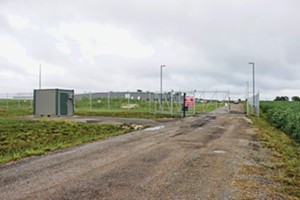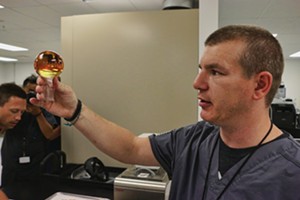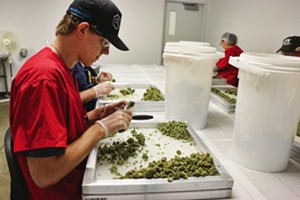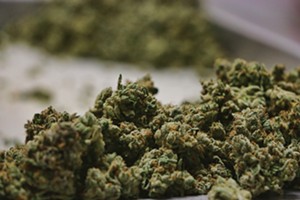See more photos in the slideshow at bottom.
Aside from the barbed wire perimeter, you’d never know from its appearance that this low, gray warehouse on a rural road lined with soybeans is anything noteworthy. Inside, however, are hundreds of marijuana plants, a sophisticated research laboratory and security measures on par with a nuclear power station.
Located near Delavan, Illinois, about 50 minutes by car north of Springfield, the warehouse is a legal cultivation center licensed under the Illinois’ Medical Cannabis Pilot Program. Illinois is still in the early stages of its program, which became law in 2013. As the state figures out how to best regulate a substance that was completely illegal for decades, cultivation centers and dispensaries are taking big financial risks to build a legitimate industry around marijuana. The building in Delavan, which is home to a company called Revolution Cannabis, represents a new frontier as Illinois experiments with medical marijuana and the federal government sets the stage to maybe, someday, possibly, legalize this demonized plant.
Revolution Cannabis is one of 19 licensed marijuana cultivation centers in Illinois. State law limits the number of cultivation centers to 22, but three slots remain unfilled. On Aug. 15, Revolution allowed reporters inside its cultivation center, marking the first time outsiders have been allowed inside such a facility in Illinois while marijuana is present. Revolution had to get permission from the Illinois Department of Agriculture, which oversees cultivation centers, and regulators from the state were present for the tour.
To get inside Revolution’s cultivation center, visitors first phone a security guard from a sliding gate outside the building. Once inside the gate, visitors must enter a magnetically locked door to the main entrance, show identification to a man behind a thick glass window and be buzzed into a hallway, where a security guard uses a metal detector wand to search for weapons. Cellphones must be left in cars or with the man behind the glass. Every door – even the bathroom – has a security lock that requires a badge and key combination to open. Every inch of the facility is visible to security cameras, and the footage is retained for a year.
In addition to the tight security, the facility has several measures in place to prevent contamination and plant disease. Visitors step through the main entrance into a shallow basin of liquid that cleans shoes, and sticky pads located throughout the facility trap any debris picked up along the way. Visitors wear cloth boots over shoes and body suits made of Tyvek, the plastic material used in home construction.

Tim McGraw, founder and CEO of Revolution Cannabis, says Revolution employs more than 40 people at the Delavan facility, and the company has a second cultivation center in the small town of Barry, Illinois, near Quincy. Employees wear scrubs and are subject to searches – per state law – to make sure legal marijuana doesn’t find its way to the street illegally. There’s a locker room in each bathroom where employees change from street clothes into scrubs.
Dustin Shroyer, COO of Revolution Cannabis, says the facility recycles its water – including the humidity from the plants’ respiration. The water is purified through reverse osmosis and treated with ultraviolet light to kill pathogens.
Behind some of the secured doors are rows and rows of marijuana plants beneath bright lights that stimulate growth. The plants are separated into different rooms by their stage in the growth process, with young “vegetative” plants under 18 inches in one room, flowering plants in another, and “mother plants,” which supply seeds, stored elsewhere. McGraw says Revolution has a genetics program in which the plants are selectively bred, meant to emphasize the positive traits and eliminate negative traits.
“Understanding the chemistry of the plant is what we’ve not done for the last 70 years,” McGraw said. “The study of cannabis and its entourage effects has been almost nonexistent. Because of our breeding program and because of how sophisticated this facility is, we’re going to be able to make advances in the chemistry of cannabis that have not been seen before.”
McGraw says the 75,000-square-foot facility started operation in July 2015 and had its first harvest in November.
An industrial dehumidifier whirs loudly in the drying room, where all four walls are lined with what look like fancy wire coat hangers holding marijuana buds. Workers in a nearby kitchen create sweets like fudge infused with cannabis oil. In another room, workers use small scissors to precisely trim the dried buds, while The Eagles’ “Hotel California” plays softly in the background.
Besides growing plants for the medical marijuana program, the facility has a research center with an advanced laboratory that would make Walter White, the meth chemist character in the popular TV series “Breaking Bad,” jealous. The lab is filled with expensive machinery used to analyze, extract, manipulate and test the compounds within marijuana’s potent buds. The goal, McGraw says, is to make better medicine. Shroyer adds that the researchers in the lab expect to have new and better products on the market in two to five years.

On display in the lab are several forms of cannabis extract. A yellow, transparent, gummy resin on parchment paper can be peeled and stretched like taffy. “Shatter” is a more glass-like and brittle form of the same thing, while an opaque form called “crumble” looks like a sea sponge and lives up to its name.
McGraw proudly holds up a small, round vial of amber-colored CO2 oil, made by using high temperature and pressure to dissolve the plant’s extract in “supercritical” carbon dioxide, which is later removed. The process allows precise separation of the various compounds in the extract without using solvents. That means the resulting oil can be customized with higher or lower levels of a particular component, and without adding dangerous chemicals.
When McGraw turns the vial upside-down, the viscous oil barely moves, like a thick tree sap.
“This is some of the purest cannabis oil in the world,” he said.
Legal limbo
Illinois cultivation centers – along with dispensaries and the patients they serve – exist in a strange but currently stable legal situation. Regardless of Illinois’ medical cannabis program and a recent state law that decriminalized small amounts of marijuana, the plant is still highly illegal under federal law. The federal Drug Enforcement Agency just declined a petition from two state governors to reclassify marijuana from Schedule I, which also contains heroin and LSD, to Schedule II, a group of supposedly less dangerous drugs which includes cocaine and methamphetamine. (The logo for the DEA’s Domestic Cannabis Eradication/Suppression Program depicts a bald eagle with talons open, swooping down on a marijuana plant. Subtle it is not.)
In 2014, Congress passed a law banning the DEA from interfering with states implementing medical marijuana programs. The DEA interpreted the law as protecting state governments, but not medical marijuana businesses or consumers, so the agency has sporadically continued raiding medical marijuana operations in some states. (No cultivation center or dispensary which is legal under Illinois law has been raided.) On Aug. 17, a federal appeals court ruled that the Department of Justice can’t prosecute medical marijuana businesses that are compliant under state laws.
In refusing to reclassify marijuana earlier this month, the DEA cited a high potential for abuse, a lack of “currently accepted medical use” and a lack of “accepted safety for use under medical supervision.”
McGraw scoffs at the decision, calling it ridiculous.
“What the DEA said was that the FDA hasn’t said there’s medicinal use,” he said, referring to the U.S. Food and Drug Administration. “So they blame the FDA, but it’s a Catch-22 because the FDA says the DEA says it’s Schedule I. It’s nonsense.”
Critics of the DEA’s anti-marijuana stance point out that the agency has for decades all but prohibited research on marijuana. The same day that the DEA announced it wouldn’t reclassify marijuana, however, it also announced relaxed rules for research on the plant, paving the way for new clinical studies. McGraw hopes to work with researchers at a university to do clinical trials on the products his lab creates.

In the center of the sort-of-legal situation surrounding marijuana in Illinois are two state regulators from Springfield who, just a few years ago, would have been tasked with arresting and prosecuting marijuana growers. Jack Campbell, former undersheriff for the Sangamon County Sheriff’s Office, is now the director of the Medicinal Plants bureau for the Illinois Department of Agriculture, which oversees cultivation centers in the medical cannabis program. Jeff Cox, a former prosecutor in the office of the Sangamon County State’s Attorney, is now acting bureau chief of Medicinal Plants under Campbell.
Both men say their focus hasn’t changed; they’re still tasked with making sure the industry follows the law and administrative rules.
“I spent eight years prosecuting all types of crimes, including some drug crimes,” Cox said. “It was definitely a big change of pace, but I’m still a regulator of it. I still look at it with a law enforcement attitude to make sure they are compliant.”
Campbell says he was recruited to run the medical marijuana program in large part because of his well-documented position against marijuana.
“They wanted somebody with a law enforcement background,” Campbell said. “I had my concerns, and I voiced them throughout my career,” Campbell said. “Now that I’ve been here and seen the strict guidelines and the adherence by the cultivation centers to all of the administrative rules … I have been satisfied.”

Cox adds that Illinois’ strict regulations on medical cannabis are important because the program is still an experiment.
“I think it lends a lot of legitimacy to the program,” Cox said. “All the cultivation centers do a very good job of following the rules and going through us before they make a major decision to make sure they’re not going to be out of compliance.”
The regulations are indeed strict – sometimes even severe. In addition to the tight security requirements, cultivation centers like Revolution Cannabis can be accused of illegally advertising to patients if a photo of one of their product labels ends up in a media report. The fine can be up to $50,000. Photos depicting the name of a marijuana strain are also verboten. A state regulator visits each cultivation center once per week and spends an entire day inspecting the facility. Patients applying for a medical cannabis license must be fingerprinted at their own expense – a requirement no other state has. The rules go on and on.
Criticism has been leveled at the secrecy surrounding the state’s program. The law creating the medical cannabis program specifically exempted it from the Illinois Freedom of Information Act, which covers disclosure of public records by state and local governments. For example, state agencies are forbidden from releasing to the public any data about applications from dispensaries, cultivation centers and patients. A state employee who violates that prohibition can be charged with a criminal misdemeanor and fined $1,000. That means the public has no way to evaluate whether cultivation and dispensary licenses were awarded fairly and ethically. There’s also no way to determine whether the patient application process is unfairly discriminatory – a charge leveled by critics who say some of the requirements exclude minority applicants.
Thriving or surviving?
Despite the strict rules, industry leaders in Illinois say they’re confident that they’ll see a return on their substantial investments. For cultivation centers, that investment includes a $2 million bond, a $25,000 application fee, another $200,000 permit fee after the application is accepted and a $100,000 permit renewal fee each year – before any other costs like construction, legal fees, business consulting and employee salaries. There are separate but similarly high fees for dispensaries. Critics claim that the hefty fees create an unfair barrier to entry into the industry for anyone without deep pockets.
McGraw said it has been “a struggle” for the industry so far because of the limits on which patients qualify to use medical marijuana. He adds that recent developments in Illinois’ program have made the industry more viable.
Over the past two months, two court rulings ordered Illinois to add post-traumatic stress disorder and irritable bowel syndrome to the list of approved medical conditions for participation in the medical cannabis program. Illinois subsequently added PTSD and terminal illness to the list and made it easier to add new ones in the future. Four more court cases are pending against the state regarding other conditions.
McGraw and others in the cannabis business see those developments and the DEA’s shift on research as further evidence that lawmakers and the public are rethinking marijuana.
A handful of states decriminalized marijuana in the 1970s, but the “tough on crime” era of the ’80s and early ’90s saw the plant increasingly demonized. When California voters approved the nation’s first state-based medical marijuana program in 1996, it began a slow trickle of states backing away from the war on marijuana. Although it varies widely by state, 42 states have some form of medical marijuana program, along with the District of Columbia, Guam and Puerto Rico. Twenty-five states have now decriminalized small amounts of marijuana, and just since 2012, four states have completely legalized small amounts for recreational use.
In July, Gov. Bruce Rauner approved a law that decriminalized possession of marijuana under 10 grams and reduced penalties for possessing higher amounts.
Meanwhile public opinion polls show a steady increase in the percentage of people who support marijuana legalization, along with a smaller but still significant increase in the percentage of people who admit to marijuana use.
Trouble with the slide show? Try the direct link.
Political observers have speculated that President Obama could order marijuana legalized at the federal level on his way out of office next year. However, the White House officially opposes marijuana legalization, saying that would increase its availability and normalize its use.
Still, the tide among the states appears to favor marijuana, and that’s what matters to the industry – as long as the DEA doesn’t mount a major effort to interfere. Given that, the gamble among marijuana entrepreneurs in Illinois seems likely to pay off.
Will decriminalization or possible legalization drive the street price of marijuana below what legitimate cultivation centers like McGraw’s can provide? He doesn’t think so. The quality of the plant matters, he says, and that’s what his company offers.
McGraw says he chose to set up shop in Illinois because it was the most commercially viable state, owing to the large potential customer base and limited number of suppliers.
As of Aug. 3, medical marijuana dispensaries in Illinois have sold $16.3 million worth of cannabis since sales to the public officially began in February 2015. A total of 8,891 patients have been approved to use medical marijuana, including 64 people under age 18. As the state approves new medical conditions for the program, the number of patients will probably increase, widening the stream of revenue to medical marijuana businesses. McGraw says adding treatment of general pain to the approved conditions would lead to a rapid expansion of the patient base.
“Long term, the future of cannabis is going to be regulated,” he said. “And it should be. Anything you sell as medicine should be tested. … The program in Illinois quite literally should be an example for the rest of the country for how a cannabis program should be set up.”
Contact Patrick Yeagle at [email protected].




















